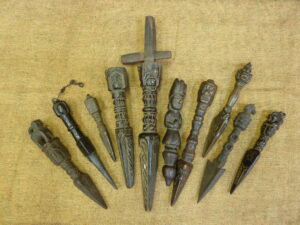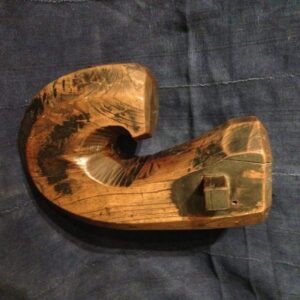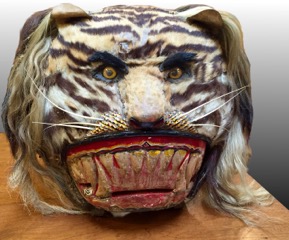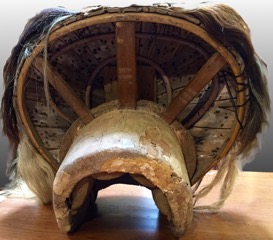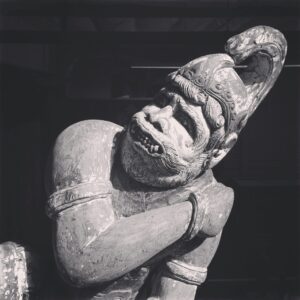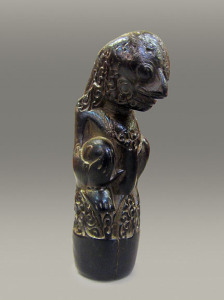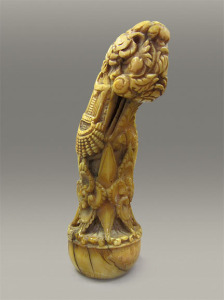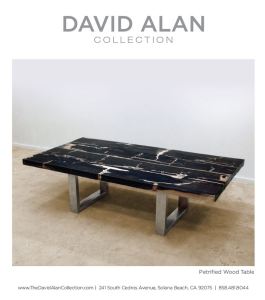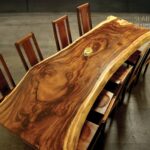Phurba – Three sided ritual dagger from Tibet – Old World Antiques
History: From Indo-Tibetan Buddhism and Indian Vedic traditions
Still used by Buddhists and Shamans in Tibet and the Himalayas, the use of these magical daggers dates back to at least the 7th or 8th century. The Phurba, or Kila in Sanskrit, is linked to a whole cycle of legends and tantric rituals which all focus on dispelling demons and evil forces. It is a spiritual weapon. It is not sharp and is not meant to cause harm to living beings.
Ritual use:
The origins of its use are shrouded in mystery but the word ‘Phur’ – meaning ‘peg’, denotes its most archaic form which was used as a magic nail or tent stake. The Phurba not only served to secure nomadic homes but also to restrain evil forces by piercing the earth so the embodied deity can sanctify the ground underneath. Its principal use has evolved into a powerful implement of exorcism used by high level Shaman and those who are initiated or empowered in its use. Most simply put, it attracts demons or negative spiritual energies and transmutes them – releasing them from suffering and guiding them to rebirth so they are no longer capable of causing harm and disruption.
The magic of the dagger comes from the effect the material object has on the realm of the spirits through the visionary ability of the Shaman.
Its function is complex and is best understood through a description of its anatomy:
It is segmented into three suites of triunes [sets of three]: 1) the Pommel or Hilt [cap at the top of the handle]; 2) the Handle; 3) the Blade.
Together they signify the three realms: the upperworld; the middle world [earth]; and the underworld. The arrangement highlights the numerological importance and spiritual energy of the integers of 3 and 9.
The Pommel represents the divine, often bearing the three faces of Buddha or the deity it embodies: one peaceful, one joyful, one wrathful (ferocious in destroying negative energy). While still embodying the deity, the pommel on some daggers may have only one head which acts as a mirror image of the Shaman in order to meditatively connect with the power of the Phurba. A horse head figure or Guardian King, can seen on some as well as other power animals.
The Handle often features a weaving or knotwork design or a dorje [thunderbolt] and serves as an energizing element connecting the hilt and blade.
The Blade is a three sided, elongated triangle representing its ability to cut through or transform the negative energies known as ‘The 3 Root Poisons’: violence; hatred; aggression / aversion; fear; hate / delusion; ignorance; misconception, as well as control over the past, present and future. The entwined serpent found on many blades is a protective deity associated with Buddha.
When guided by the practitioner, the deity will manifest as the Phurba and draw in negative energy. The demons can be drawn from the ground, from the sky or from a person (as in an exorcism) and are tied to the blade establishing an energetic continuum to hold it in place until it can be redirected. The practitioner then vertically pierces the earth with the blade, or if indoors plunges it into a bowl of rice or grain, connecting space to earth thus destroying (in the sense of transmuting and freeing) the demons.
Phurbas, particularly those of wood, are also used for healing and dispelling disease, evil thoughts and desires. For this, the blade is dipped into a bowl of water, stirred and the water given to the patient to drink.
Materials: Although they can be constructed from many different materials, Phurba’s, like most Tibetan ritual instruments are most often made of wood, brass or iron, the most valuable being of meteoric metal [‘Thogcha’ or ‘sky-iron’].
Above image – From left to right: Nepal Phurbas 80 – 100 years old
1) Wood, 3 faced pommel with tiger-like animal at top – $190. (SOLD)
2) Wood, 3 faced pommel with forged chain; iron clad round blade (9 1/2″ x 1 1/2″) – $650. (SOLD)
3) Wood, 4 faced pommel; monkey depicted on blade (6 1/2″ x 1″) – $200.
4) Wood, 3 faced pommel (10 1/4″ x 1 7/8″) – $400.
5) Wood, 3 faced pommel with cross pin, cobra serpent on blade (17″ x 4 1/2″ x 2″) – $ 550. (SOLD)
6) Wood, single praying human figure; short, round blade (9 1/4′ x 1 3/4″) – $270.
7) Wood, 3 faced pommel (11 1/2″ x 1 1/2″) – $ 475. (SOLD)
8) Metal – brass, 3 faced with 3 face headdresses pommel – $650. (SOLD)
9) Metal – iron, 3 faced pommel with horse head guardian on top; Djorie handle (10″ x 1 3/4″) $650. (SOLD)
10) Wood, 3 faced pommel, with animal on top (9″ x 1 1/2″) $350. (SOLD)

